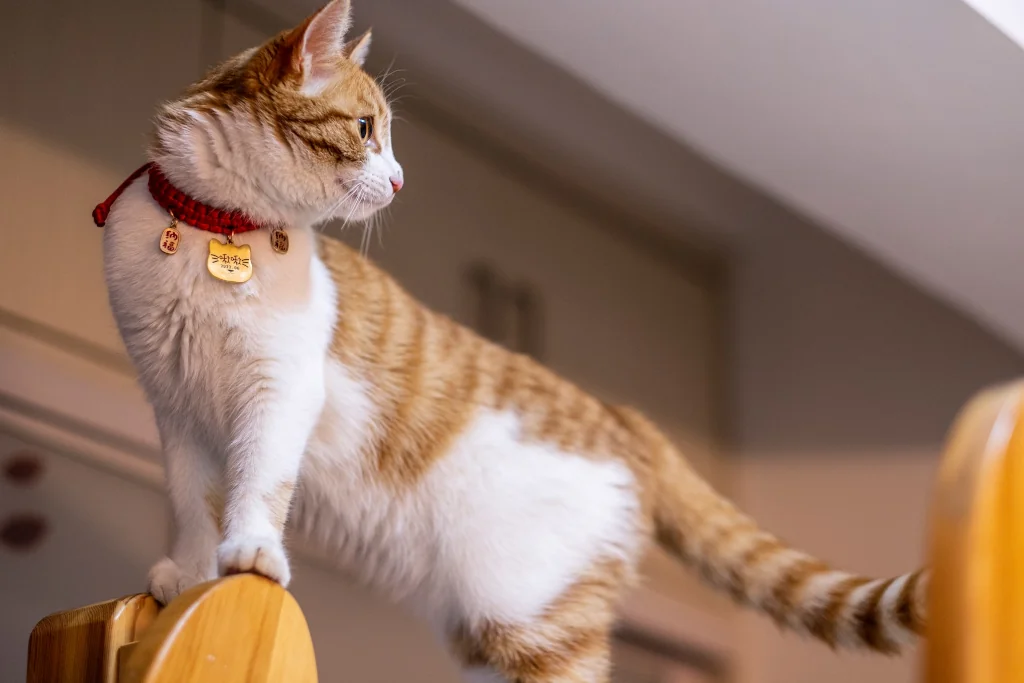Disclosure: We may earn a commission from helpful, relevant links in our content. No cost to you. See our privacy policy.
Picture this: your feline friend, always so full of mystery, suddenly jumping through a hoop or giving you a high-five.
Not quite there yet? We get it. Training your cat to do tricks might feel like trying to catch a sunbeam. It’s tricky, sometimes frustrating, and leaves you wondering if it’s even possible.
But here’s the good news – it’s not only possible, but it’s also a whole heap of fun, too! It’s time to take the leap, and who knows, you might even uncover some hidden talent your cat’s been keeping under wraps.
Before we dive into the ins and outs of cat training, here’s a quick peek at how you can teach your cat to high-five:
- Ready the Rewards – Have treats handy.
- Capture their Attention – Hold treat above their head.
- Initiate the High-Five – Present your hand near your cat.
- Timing is Key – Reward the high-five immediately.
- Practice and Patience – Keep training sessions short and sweet.
We’ll break this down further as we go along. But first, let’s talk about why you might want to consider teaching tricks to your cat.

So, Can Cats Really Learn Tricks?
You bet they can! Cats are curious by nature and possess sharp mental acuity, making them perfect pupils for learning new tricks.
Their independence might present a unique challenge, but with patience and the right techniques, you’d be surprised at what your whiskered friend can achieve.
It’s not about turning your cat into a circus performer, it’s about enhancing their natural agility and mental stimulation – and building an even deeper bond with them in the process.
Benefits of Teaching Tricks to Your Cat
Training your cat to perform tricks brings multiple benefits for both of you.
For starters, it provides mental stimulation for your cat, keeping them engaged and less prone to destructive behaviors.
More so, it promotes better communication between you two – as you guide them through tricks, you’ll learn to understand their signals better, and they’ll get used to following your cues.
But perhaps the most rewarding part is the strengthening of your bond. Each high-five, each successful jump or roll-over brings you closer, making the time spent training not just productive, but heartwarmingly precious.
What’s the Easiest Trick to Teach Your Cat?
The ‘high-five’ is usually a hit among cat owners and is often one of the easiest tricks to teach. It’s a delightful trick that not only adds a playful element to your interactions but also acts as a gateway to more advanced tricks.
It works well because it leans into your cat’s natural behavior. Think of those times your kitty reaches out with their paw to tap your hand. With a little patience and encouragement, you can turn that simple gesture into an impressive high-five!

Step-by-Step: Teach Your Cat Their First Trick
Alright, let’s jump into the nitty-gritty of teaching your cat the high-five trick:
Step 1: Ready the Rewards – Cats respond positively to treats. Have their favorite ones handy as a reward for successful execution of the trick.
As for treats, my personal recommendation would be the ‘Temptations‘ brand – they’re a hit with Sir Fluffington. Remember, the best reward is one your cat loves!
Step 2: Capture their Attention – Hold the treat just above your cat’s head to ensure their focus is on you and the delectable prize.
Step 3: Initiate the High-Five – Slowly bring down your other hand in a ‘high-five’ position close to your cat. Some cats might instinctively reach out and tap your hand.
Step 4: Timing is Key – The moment your cat taps your hand with their paw, say ‘high-five’ (and click, if using a clicker), and give them the treat and some affection. This helps them associate the trick, the command, and the reward.
For clicker training, ‘Karen Pryor Terry Ryan Clik Stik‘ is a great tool. Its distinct sound is perfect for signaling when your cat has performed a trick correctly. It combines a clicker and a retractable target stick, which can be very useful for teaching tricks.
Step 5: Practice and Patience – Repeat this process over different training sessions. Remember, patience is your best friend here. If your cat seems uninterested or stressed, call it a day and try again later.
In time, your cat will start associating the high-five gesture with a tasty treat, and you’ll have successfully taught them their first trick! Happy training!
Suggested reading: How to Train a Cat To “Sit”
How Long Does It Take for a Cat to Learn a Trick?
Ah, the age-old question, “how long?”
If I look back to when I was training Sir Fluffington, my British Shorthair, to perform his first high-five, it was clear that each cat is unique.
One day, after several weeks of daily training, I was about to call it a day, feeling slightly discouraged. Just as I was putting away the treats, Sir Fluffington glanced at me, lifted his paw, and there it was – the high-five! I can still remember the sparkle in his eyes – a moment of shared accomplishment that was truly special.
This incident perfectly illustrates the fact that it depends on your cat’s personality, interest, and your consistency in training.
Generally, for a simple trick like a high-five, it might take a few weeks of regular, short training sessions.
Remember, the key is not to rush it but enjoy this bonding journey with your feline companion.
Improve your cat behavior by teaching your cat:
- to sit
- to stay
- to come to you,
- to ‘leave it’,
- to meow
- to use a scratching post
- and to get off the counter
FAQs
Are some cat breeds easier to train tricks to than others?
Certain breeds like the Maine Coon, Bengal, and Abyssinian are known for their higher intelligence and curiosity, which can often make them more receptive to trick training. However, individual personality plays a crucial role too, making any cat a potential trick superstar!
Is it okay to train a cat using a clicker?
Absolutely! Clicker training can be a highly effective method for cats. The distinct sound of a clicker can help your cat understand exactly when they’re doing the right thing, speeding up the learning process.
How much time should I spend each day on trick training?
You should aim for short but frequent training sessions, typically around 5 to 10 minutes at a time. Two to three sessions per day is a good starting point, ensuring that you keep your cat’s interest without causing them any stress.
Can older cats learn new tricks?
Certainly! While kittens may be more naturally inquisitive, older cats can also learn new tricks. Training can be an excellent mental exercise for them, keeping their brains sharp.
Alex, a passionate animal lover, has experience in training and understanding animal behavior. As a proud pet parent to two dogs and three cats, he founded AnimalReport.net to share insights from animal experts and expand his knowledge of the animal kingdom.




